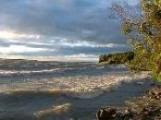Plan aimed at reviving lake Simcoe
Ontario's draft Lake Simcoe Protection Plan will create a healthy future for the lake by limiting shoreline development, decreasing pollutants and returning its fish population to vigorous levels, says Ontario's Environment Minister John Gerretsen.
Gerretsen, who calls the protection plan the first of its kind in Canada, released a draft report recently, predicting it will turn around the beleaguered lake, one environmentalists say has long been ignored by various governments, developers and recreational boaters.
"What I would like to see, 10, 15 or 20 years from now, is a healthy lake, with phosphorous levels that are acceptable, with a good sustainable fishery again, so everybody can enjoy the tremendous advantages that the lake affords to people in a number of ways," Gerretsen said in an interview.
Among the highlights of the draft plan:
The creation of shoreline protection zones of 100 metres for undeveloped areas, 30 to 120 metres in built-up shoreline areas and 30 metres in some settled areas.
Targets for reduction in the lake's single largest pollutant, phosphorous, aiming for 44,000 tonnes a year instead of the current 67,000 tonnes. (Phosphorous comes from sewage plants, storm sewers, septic systems, urban and agricultural run-off and airborne particles.)
Master plans for municipal controls on storm-water runoff, another major source of pollution.
Available for public input for 60 days, the draft plan was greeted with both delight and disdain by environmental groups.
"Any plan that purports to protect Lake Simcoe is phenomenal," said Bob Eisenberg of the Rescue Lake Simcoe Coalition.
But Eisenberg and others, like Rick Smith of Environmental Defence, say many parts of the plan are nothing more than targets with no real power to force change.
Smith said the plan fails to address new marina and resort development, does not properly deal with boat congestion and allows for the grandfathering of large developments, like Big Bay Point.
Comments on this story are moderated| Login to Comment Commenting Guidelines



